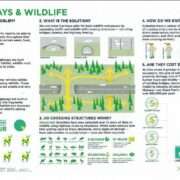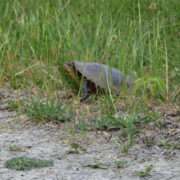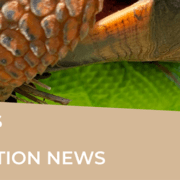Breaks in ecological corridors
Forest fragmentation
Why is it important to connect parcels of land and maintain open corridors?
- Did you know that you need to be 200 to 300’ from the forest edge for the sound of cars and lawn mowers to be muffled and to be able to find a cool, shady spot where the forest floor is still damp even during a 3 week drought?
- It takes 14 acres of forest to have just one such acre in the centre where the truest forest conditions exist?
- A residential pocket inside a forest affects up to 30 additional acres with disturbances?
Forest fragmentation occurs by the introduction of roads, agriculture, utility corridors, subdivisions etc. The greater the fragmentation, the faster the disappearance of the forest. Think about ice cubes. The smaller the cube, the faster it melts.
Many species are at the northern limit of their habitat. With the effects of climate change we will continue to see a movement of species, northward into our region.
“Ecological networks are a vital conservation strategy for supporting biodiversity as it responds to climate change. Changing climate conditions are forcing species to shift their ranges. Over the long term, connectivity science can respond to the risks posed by climate change by quantifying habitat and movement needs, predicting how they will change, and identify opportunities to protect large networks of habitat to safeguard connectivity and support species in the long-term.”
Excerpt taken from: A review of ecological connectivity science in the Region of Resolution 40-3 Executive Summary. An Assessment of the Science and Projects Describing the Ecologically Connected Landscape of the Northeast Region of North America.
https://www.connectiviteecologique.com/sites/default/files/2021-07/Connectivity-Analysis-40-3_Summary_EN.pdf
- Forest fragmentation leads to the loss of biodiversity, reduction in forest health and water quality, increased threat from invasive plants, species and pathogens.
- Quebec wants to conserve 30% of its land by 2030, in 8 years. At the moment only 17% is protected.
- 91% of the land in the Eastern Townships is privately owned. Therefore it is essential to speak about conservation methods and find ways to reach property owners, educate them about the benefits of conservation.

https://www.corridorappalachien.ca/wp-content/uploads/2022/04/CorridorAppalachien_Bulletin-Printemps_EN_WEB_20220413.pdf
The Massawippi Conservation Trust currently owns or has under its protection, 1,200 acres of land (485 hectares of land). The vast majority is contiguous and on the western ridge of Lake Massawippi. This virgin forest is know for its clean water and healthy habitat which supports many species of salamanders. These important creatures may act as an indicator species of the ecological integrity of the forest they occupy together with the earthworm.
Land use planning is a tool that can be used to protect essential habitats.
As stated in the Appalachian Corridor website: Municipalities and MRCs have access to many tools to generate positive outcomes for the environment and can use their regulatory powers to contribute to the conservation of nature. Municipalities can capitalize on the following levers to foster the health and conservation of natural areas:
• Zoning bylaws
• City or town planning master plan
• Site planning and architectural integration plans
• Conditional uses
• Delivery of permits and certificates
• Municipal works agreements
• Tree planting and tree felling/logging regulations
• Vegetation cutting/mowing bylaws
• Outdoor lighting regulations
• Subdivision bylaws For instance, municipalities can adopt a nature-friendly approach to land use planning and bylaws, limiting the destruction or the degradation of the most sensitive features on a territory such as summits, steep slopes, or riparian areas.
Municipalities can also establish a legal conservation status on properties they own. Nature conservation can also be taken to a whole new level when neighbouring municipalities work together to develop and integrate a comprehensive and holistic conservation vision. In addition to supporting the region’s municipalities in advancing their projects for the conservation and protection of natural areas, Appalachian Corridor recently launched a guide to support municipalities and MRCs throughout Québec. This guide, structured in the form of two toolboxes, provides guidelines to encourage municipalities and MRCs to foster ecological connectivity and natural area conservation on their territories. These tools were developed as part of the Initiative québécoise Corridors écologiques.
https://www.corridorappalachien.ca/wp-content/uploads/2022/04/CorridorAppalachien_Bulletin-Printemps_FR_WEB_20220413.pdf
You don’t own land?
How can you help?
Find out if your municipality has any environmental plans, has it updated its zoning laws to reflect current realities? Get involved with your municipality and local regional governments. Join an environmental committee. Use your voice and your vote.
‘Woods Whys’ by Michael Synder (published by Bondcliff Books) who wrote for years for the Vermont Woodlands magazine and who is currently a Vermont State Forester and Commissioner with the Vermont Department of Forests, Parks & Recreation.
Our affiliated partner Appalachian Corridor who organised a very informative webinar on the importance of ecological corridors and have participated in studies and research papers over the years on the importance of the corridors in our local area not to mention many other topics in line with conservation.








